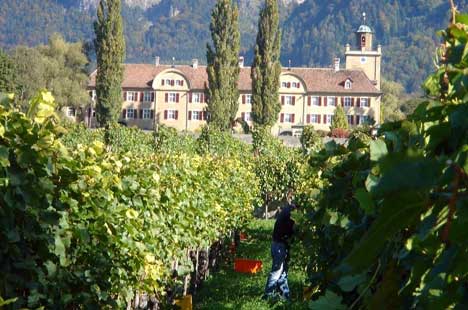Actually, I am busy learning to better understand a piece of "world history" in the novel "Der Turm" by Uwe Tellkamp, almost a thousand pages long: the "downfall" of the GDR. But then a friend thrust a small, black booklet - just over two hundred pages - into my hand: "Bitterer Abgang in Maienfeld" by Markus Matzner. A crime novel. The author is not a man of letters, his language is simple, direct, straightforward, journalistic. Markus Matzner is a professional - a journalist - as a young reporter he was once in my team on television. He knows the journalist's profession; but he also knows the world of wine. A few years ago, he wrote a wine book: "Zapfen ab". Now he is trying his hand at a crime novel set in a well-known Swiss "wine village".
 |
| Markus Matzner's crime novel depicts the atmosphere in a winegrowing village |
So I leave German history, return for a short time to the more familiar winemaking milieu of Switzerland. Interruption of big politics, return to local colour. The author states at the beginning: "All events in this novel are freely invented ..... solely from the author's imagination and without reference to real persons."
Pure fantasy? Or a piece of reality after all? This arouses my interest, because it is precisely in this village, in this wine region, that I stand in the vines every autumn to bring in the harvest. Mainly Pinot Noir, just as it is described in the novel. "Everywhere there are hard-working helpers who work their way through the sea of vines and harvest every vine. The rotten berries cut away and the good ones placed in the transport containers....." That's how I know the work, and it's the same in all wine regions of the world, at least where they still harvest by hand.
 |
| The grape harvest in the Bündner Herrschaft is called "Wimmlen"% the vineyard "Wingert" and the wine cellar "Torkel" |
The winegrowers' thriller in a famous village in the "Bündner Herrschaft" is probably more than just the fantasy of a wine-loving author. It is the meticulous description of a world that exists in Switzerland. Rather hidden, entangled in everyday life, usually without any criminalistic attitudes, without obvious fraud or even murder. It is the world of a small Swiss village famous for its wines. But it is even more famous as the setting for a classic of children's literature: "Heidi's Years of Learning and Wandering", written in 1879 by the Swiss author Johanna Spyri: "From the friendly village of Mayenfeld, a footpath leads through green, tree-filled meadows to the foot of the heights that look down on the valley from this side. Where the footpath begins to climb, heath land with its short grass and strong mountain herbs soon begins to smell of what is to come, for the footpath goes steeply and directly up to the Alps." Thus begins the Heidi story, which has since been translated into some 50 languages.
 |
| Grape harvest in Maienfeld. Salenegg Castle in the background |
"Heideland" - or just "Heidiland" - lies far up, in the mountains, where cattle graze in summer, where there are no vines. In fact, the word vine or even wine never appears in Johanna Spyri's famous "development novel"; they are faded out of reality, even though wine was already grown in the area a hundred and thirty years ago, especially in the four villages of the "Bündner Herrschaft". According to tradition, the Blauburgunder grape is said to have been brought to Switzerland from Burgundy in France to Graubünden by the Breton marshal Henri de Rohan in the 17th century. But much earlier, first mentioned in a document in 1068, "stately" wines were already being grown and pressed at Salenegg Castle in what is said to be the oldest vineyard in Europe.
 |
| Salenegg Castle% Europe's oldest vineyard |
The "Bündner Herrschaft" is not an administrative district, not a politically defined institution, not even a wine appellation. And yet it is the most famous wine-growing region in German-speaking Switzerland, the cradle of Swiss Pinot. There are four independent municipalities in which about 300 winegrowers cultivate around 350 hectares of vines, 70 percent of which are Pinot Noir. In Maienfeld, the "main village" of the "dominion", strange things are now happening, but only in the detective story. The village is afflicted by "plagues", only three of the ten biblical ones, but this is enough to stage a crime tango in the village. It is this "tango" that fascinates me, not the hunt for the villain. For once, a novel draws a milieu that is amazingly real - not in terms of the story but rather in terms of the atmosphere - in the everyday life of the inhabitants, in the coexistence and togetherness of the winegrowers. A piece of current winegrowing in Switzerland is described quite precisely and made tangible for everyone. Love, intrigue and murder are only additions to make everything more attractive that we no longer even notice in everyday life or so readily overlook.
 |
| Bündner Herrschaft% above the still young Rhine% at the foot of the mountains. |
The detour from Dresden - where Tellkamp's "Turm" paints a morbid milieu - to the village of 2,500 inhabitants, where with Matzner one encounters good but also mischievous winegrowers, was worthwhile. There is often more reality in fiction than in many descriptions that try to capture reality. Everything that does not fit into the beautiful, coherent picture can then be confidently assigned to the fantasies of the authors.
Sincerely
Yours sincerely
Peter (Züllig)